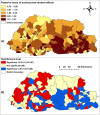Spatio-temporal patterns of childhood pneumonia in Bhutan: a Bayesian analysis
- PMID: 34650108
- PMCID: PMC8516968
- DOI: 10.1038/s41598-021-99137-8
Spatio-temporal patterns of childhood pneumonia in Bhutan: a Bayesian analysis
Erratum in
-
Author Correction: Spatio-temporal patterns of childhood pneumonia in Bhutan: a Bayesian analysis.Sci Rep. 2021 Nov 15;11(1):22549. doi: 10.1038/s41598-021-01075-y. Sci Rep. 2021. PMID: 34782639 Free PMC article. No abstract available.
Abstract
Pneumonia is one of the top 10 diseases by morbidity in Bhutan. This study aimed to investigate the spatial and temporal trends and risk factors of childhood pneumonia in Bhutan. A multivariable Zero-inflated Poisson regression model using a Bayesian Markov chain Monte Carlo simulation was undertaken to quantify associations of age, sex, altitude, rainfall, maximum temperature and relative humidity with monthly pneumonia incidence and to identify the underlying spatial structure of the data. Overall childhood pneumonia incidence was 143.57 and 10.01 per 1000 persons over 108 months of observation in children aged < 5 years and 5-14 years, respectively. Children < 5 years or male sex were more likely to develop pneumonia than those 5-14 years and females. Each 1 °C increase in maximum temperature was associated with a 1.3% (95% (credible interval [CrI] 1.27%, 1.4%) increase in pneumonia cases. Each 10% increase in relative humidity was associated with a 1.2% (95% CrI 1.1%, 1.4%) reduction in the incidence of pneumonia. Pneumonia decreased by 0.3% (CrI 0.26%, 0.34%) every month. There was no statistical spatial clustering after accounting for the covariates. Seasonality and spatial heterogeneity can partly be explained by the association of pneumonia risk to climatic factors including maximum temperature and relative humidity.
© 2021. The Author(s).
Conflict of interest statement
The authors declare no competing interests.
Figures





Similar articles
-
Identifying socio-ecological drivers of common cold in Bhutan: a national surveillance data analysis.Sci Rep. 2022 Jul 9;12(1):11716. doi: 10.1038/s41598-022-16069-7. Sci Rep. 2022. PMID: 35810192 Free PMC article.
-
Spatial and temporal patterns of dengue incidence in Bhutan: a Bayesian analysis.Emerg Microbes Infect. 2020 Dec;9(1):1360-1371. doi: 10.1080/22221751.2020.1775497. Emerg Microbes Infect. 2020. PMID: 32538299 Free PMC article.
-
Spatial and temporal patterns of diarrhoea in Bhutan 2003-2013.BMC Infect Dis. 2017 Jul 21;17(1):507. doi: 10.1186/s12879-017-2611-6. BMC Infect Dis. 2017. PMID: 28732533 Free PMC article.
-
A spatio-temporal analysis to identify the drivers of malaria transmission in Bhutan.Sci Rep. 2020 Apr 27;10(1):7060. doi: 10.1038/s41598-020-63896-7. Sci Rep. 2020. PMID: 32341415 Free PMC article.
-
Spatiotemporal transmission and socio-climatic factors related to paediatric tuberculosis in north-western Ethiopia.Geospat Health. 2017 Nov 27;12(2):575. doi: 10.4081/gh.2017.575. Geospat Health. 2017. PMID: 29239568
Cited by
-
SPATIAL MODELING OF RISK FACTORS FOR UNDER-FIVE PNEUMONIA IN ROKAN HILIR DISTRICT, INDONESIA.Afr J Infect Dis. 2025 Apr 7;19(2):15-32. doi: 10.21010/Ajidv19i2.3. eCollection 2025. Afr J Infect Dis. 2025. PMID: 40417383 Free PMC article.
-
Aetiologies and Risk Factors of Prolonged Fever Admission in Samtse Hospital, Bhutan, 2020.Int J Environ Res Public Health. 2022 Jun 27;19(13):7859. doi: 10.3390/ijerph19137859. Int J Environ Res Public Health. 2022. PMID: 35805518 Free PMC article.
-
Spatial patterns and spatially-varying factors associated with childhood acute respiratory infection: data from Ethiopian demographic and health surveys (2005, 2011, and 2016).BMC Infect Dis. 2023 May 5;23(1):293. doi: 10.1186/s12879-023-08273-1. BMC Infect Dis. 2023. PMID: 37147575 Free PMC article.
-
Identifying socio-ecological drivers of common cold in Bhutan: a national surveillance data analysis.Sci Rep. 2022 Jul 9;12(1):11716. doi: 10.1038/s41598-022-16069-7. Sci Rep. 2022. PMID: 35810192 Free PMC article.
References
-
- WHO . Pneumonia, The Forgotten Killer of Children. UNICEF/WHO; 2006.
-
- WHO. Pneumonia. https://www.who.int/en/news-room/fact-sheets/detail/pneumonia (2019).
-
- Institute for Health Metrics and Evaluation (IHME) Findings from the Global Burden of Disease Study. Institute for Health Metrics and Evaluation (IHME); 2018.
-
- (IVAC), I. V. A. C. 1–42 (Johns Hopkins Bloomberg School of Public Health, 2015).
MeSH terms
LinkOut - more resources
Full Text Sources
Medical

